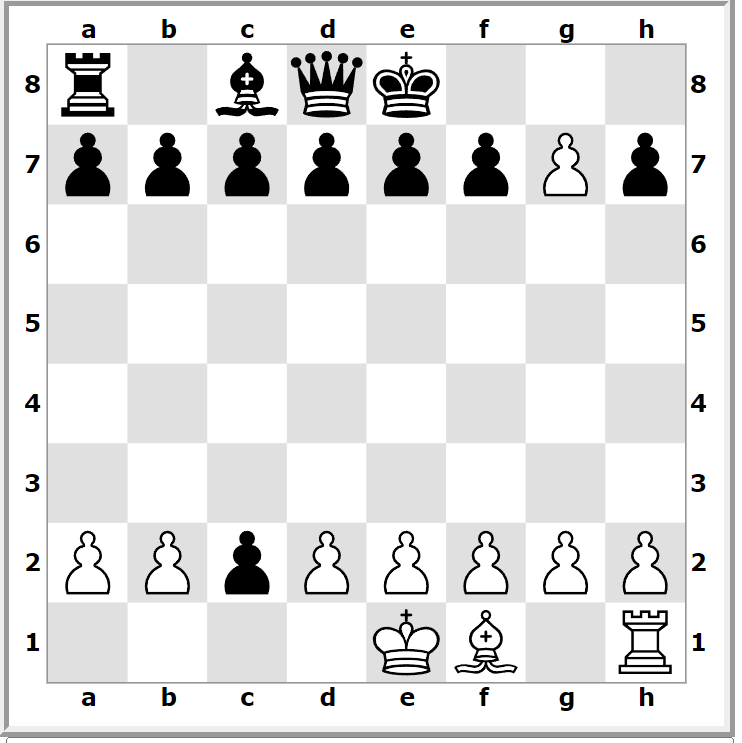Permutations (chess)
(Dall.e creation)
[A]
[A] White has just played his 8th move and his rooks have swapped;
does the above diagram become legal with a black pawn on d6?
[B]
[B] After the 10th black move in a game of orthodox chess,
the two kings managed to exchange their original places,
leaving a symmetrical position on the board: which one?
(the above position is the starting one of the 10 moves)
[C]
[C] No pawn moved during this orthodox chess game, except two:
the original c2 pawn is now on the square g7 and the original g7 pawn is now on the square c2.
Of the 32 starting pieces, how many, at most, can still appear on this board?
_______________________________
Solutions
[A] As Jean-René Koch guessed on the France Échecs forum, the answer is no (English translation follows):
– J’ai l’impression qu’il manque un pion en d5 sur le diagramme initial. Avec ce pion on atteint la position de la façon suivante :
1.a4 d6 2.h4 Fd7 3.Th3 Fxa4 4.Txa4 Dd7 5.Tha3 Dg4 6.Ta1 Dxh4 7.Txh4 d5 8.Th1
Et là la question initiale a du sens : est-ce qu’on peut atteindre la même position avec le pion en d6 au lieu de d5, c’est-à-dire en se privant du "coup d’attente" 7...d6-d5 ? Ma première intuition est que ce n’est pas possible.
[translation]
— I have the impression that a pawn on d5 is missing on the initial diagram. With this pawn we reach the position in the following way:
1.a4 d6 2.h4 Bd7 3.Rh3 Bxa4 4.Rxa4 Qd7 5.Rha3 Qg4 6.Ra1 Qxh4 7.Rxh4 d5 8.Rh1
And there the initial question makes sense: can we reach the same position with the pawn on d6 instead of d5, that is to say by depriving ourselves of the "waiting move" 7.. .d6-d5? My first intuition is that this is not possible.
[B]
1. f3 f6 2. Kf2 Kf7 3. Kg3 Ke6 4. Kh4 Kf5 5. Kh5 Kf4 6. h3 h6 7. Kg6 Kg3 8. Kf7 Qe8+ 9. KxQ Kf2 10. Qe1+ KxQ
[C]
The original white pawn c2 has captured the 4 black missing pieces to reach g7.
The original black pawn g7 captured 4 times also. But one black Knight (for instance) had to capture the white Bishop on c1 in order to release the white Rook on a1 (the 4th white piece needed to allow the 4 captures by the black pawn). At most 23 pieces (see the above diagram) can still be on the board.
____________________
Next day update
Diag. [B]
> Juha Saukkola: Very nice. I have never imagined, that it's possible.
Diag. [C]
> Noam D. Elkies:
> Looks like 23: each of those two pawns captured 4 times, so at most 32 - 4 - 4 = 24; but while Black easily provides 4 captures after moving the g-pawn, White can lose only QNN unless Black also captures the Bc1 at home (which can be done with any of N,R,Q) so the Ra1 can get out and be captured too. It then looks easy to swap the c2/g7 pawns without further sacrifice.
> I wonder if it's possible to set up 24 in Losing Chess — then wK can be captured too, but care is needed to avoid putting line pieces where they can be required to capture something else.
> I later noticed that the statement of your puzzle allows one or more of the other 14 pawns to be *captured* on their home square, though the diagram accompanying the puzzle on permutations-chess.html shows a full complement of 16 pawns. The maximum of 23 could also be attained by capturing any of White's seven unmoved pawns other than the one on f2.
___________________
Thank you Juha and Noam!










Commentaires
Enregistrer un commentaire